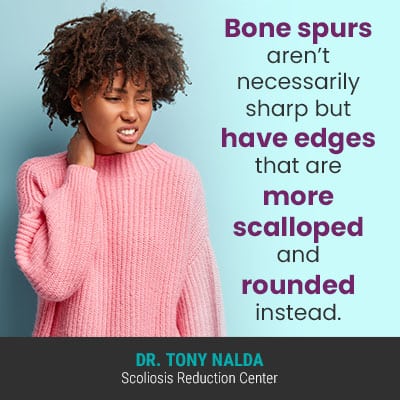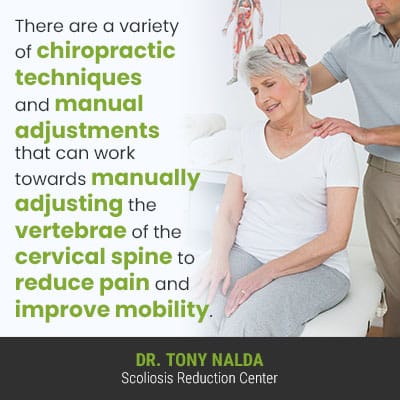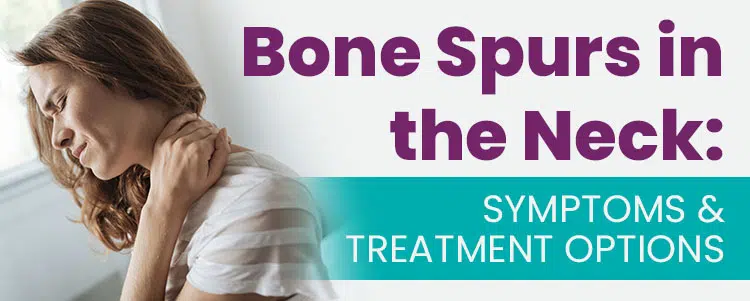The very design of the spine is based on movement, so it has many important moveable structures. When it comes to spinal bone spurs, we are talking about bone growths that form on bone edges or in the joints of the spine; cervical bone spurs develop in the neck and can cause a loss of space within the spine, which houses important spinal nerves within.
Bone spurs are bony growths that project from bone edges, or where bones meet: in the joints. Bone spurs in the neck can cause a variety of symptoms, and treatment needs will be case-specific and driven by the underlying cause of the cervical bone spurs.
For a better understanding of just how bone spurs affect the function and health of the cervical spine, let’s start with some basic spinal anatomy.
Spinal Anatomy and Function
The spine is a key structure of the body. Not only does it allow us to stand upright, practice good posture, engage in flexible movement, and absorb/distribute mechanical stress, it also works in tandem with the brain to form the central nervous system (CNS).
The central nervous system facilitates brain-body communication, so it is involved in the function of virtually every working system within the body.
A healthy spine is naturally curved, giving it a soft ‘S’ shape when viewed from the sides, and appearing straight when viewed from the front or the back.
In order for the spine to function optimally, it needs to maintain its natural curvatures and alignment, which make the spine stronger and more flexible.
There are three main spinal sections: Cervical (neck), thoracic (middle/upper back), and lumbar (lower back).
As the spine is one structure, the integrity of each spinal section is dependent upon the health of the others; if one spinal section loses its natural curve or alignment, it can disrupt the biomechanics of the entire spine.
The spine is made up of rectangular-shaped vertebrae (bones of the spine) stacked on top of one another in a straight and neutral alignment, but if one of those vertebrae is misshapen or damaged in some way, the spine can become misaligned.
The vertebrae have hollow openings at their centers, through which important spinal nerves are housed and pass through to project to different areas of the body.
In order for spinal nerves to function properly, they need optimal space.
Intervertebral discs separate the vertebrae; these discs provide cushioning between adjacent vertebrae, combine forces to enable flexible movement, act as the spine’s shock absorbers, and give the spine structure.
The discs consist of two main components: a soft gel-like interior called the nucleus and a durable and tough outer layer known as the annulus.
In fact, when it comes to natural age-related spinal degeneration, the intervertebral discs are usually the first spinal structures to feel those effects.
Bone spurs in the neck can sometimes be associated with scoliosis, which may cause headaches, these headaches are due to the resulting spinal misalignment and tension in the surrounding muscles.
Hyperlordosis can contribute to the development of bone spurs in the neck, leading to symptoms such as pain and restricted movement, for which various treatment options are available.
So what are bone spurs, and how do they affect overall spinal health and function?
Cervical Osteophytes
Bone spurs, also called osteophytes, are bony outgrowths that form on the edges of bones, or where they meet, in the joints, and can develop in multiple areas of the body, including the spine.
As mentioned, there are three main spinal sections, and when bone spurs form in the cervical spine, these are also known as neck spurs, and the cervical spine consists of the spine’s first seven vertebrae (C1 to C7).

Are cervical bone spurs dangerous? Bone spurs aren’t necessarily sharp but have edges that are more scalloped and rounded instead.
Symptoms of Bone Spurs in the Neck
Spinal osteophytes are a normal indicator of natural age-related spinal cord degeneration(degenerative disc disease), and while some neck spurs won’t be overly noticeable (many are discovered during X-rays for other issues), they can cause:
- Pain at the site
- Tingling
- Numbness
- Weakness
- Radicular pain felt in the neck, shoulder, arm, or hand
- In some very rare cases, it has been noted that bone spurs may lead to loss of bowel or bladder control
The cervical spine has to support the weight of the neck and head, making it vulnerable to degenerative changes and poor posture.
The cervical spine facilitates the neck’s flexible movement: turning the head side to side, and looking up and down.
When a spinal condition that involves the neck develops, it can cause a decreased range of motion, making those much-needed movements more difficult and sometimes painful.
Now that we have explored some basic spinal anatomy and defined cervical bone spurs. Let’s address some common causes of neck spurs.
What Causes Bone Spurs in the Neck?
Bones are like hair and fingernails, constantly renewing and changing, but if tissues surrounding a bone become inflamed and/or damaged, this can affect nearby bone growth.
Osteophytes can form where new bone cells are deposited in unusual locations: on bone edges or where they meet.
Most often, neck spurs form where tendons and ligaments around cervical vertebrae are damaged and/or inflamed and are the result of wear and tear on the spine that occurs over time.
This brings us to the most common cause of cervical osteophytes: cervical osteoarthritis.
The most common type of arthritis, osteoarthritis, affects millions of people around the world, and develops as the protective cartilage that cushions bone edges breaks down over time.
While osteoarthritis can cause damage to any joint, the condition is most known to affect the hands, knees, hips, and spine.
As the joints of the neck start to degrade, this includes the disc spaces (types of modified joints), the facet joints of the spine, and the uncovertebral joints in levels C3 to C7.
Also referred to as cervical spondylosis, cervical osteoarthritis is most common in people over the age of 40 who are experiencing natural age-related spinal degeneration.
In addition, certain lifestyle choices like carrying excess weight, leading a sedentary lifestyle, chronic poor posture (tech neck), and smoking can speed up rates of age-related spinal degeneration.
Bone spurs in the neck can cause symptoms such as pain, numbness, and weakness, and may contribute to conditions like spinal stenosis and bulging discs; treatment options range from physical therapy and medications to surgical interventions.
Treatment for Bone Spurs in Neck
Many cervical osteophytes don’t cause symptoms, so diagnosing bone spurs is often by chance. Although they are visible in magnetic resonance imaging they frequently go unnoticed until an X-ray is being done for another reason.
Treatment generally isn’t applied unless the uncovertebral spurring symptoms are causing pain and/or other symptoms and in severe cases an anterior cervical discectomy is performed.
Here at the Scoliosis Reduction Center®, I have experience treating a wide range of spinal conditions, cervical osteophytes included.
Often, it can be a matter of providing guidance for patients on activity/lifestyle modification.
Sometimes, rest and limiting strenuous activities can help reduce related chronic neck pain, and in addition, postural correction can help provide symptom relief, particularly when it comes to issues with the cervical spine because, as mentioned, the cervical spine has to support the weight of the head.
Bone spurs in the neck can lead to various uncomfortable symptoms such as neck pain, restricted mobility, and even neurological issues if they impinge on nearby structures. When these symptoms arise, exploring treatment options becomes crucial.
One potential treatment, though not directly related to bone spurs in the neck, is the Harrington Rod, which is typically used for scoliosis. However, the management of bone spurs in the neck often involves non-surgical approaches, such as physical therapy, anti-inflammatory medications, and in some cases, surgical removal. Consultation with a healthcare professional is essential to determine the most suitable treatment plan for addressing bone spurs in the neck and ensuring optimal outcomes.
Ice and heat therapy can also be helpful in relaxing neck muscles, and reducing related pain and inflammation.
There are also a variety of physical therapy exercises and stretches that, when condition-specific and recommended by a professional, can help strengthen the neck, keep it flexible, and maintain a healthy range of cervical motion.
There are also medications and muscle relaxants that can bring relief, but of course, these only offer short-term pain relief as treating pain is merely addressing a symptom, not its underlying cause.

There are a variety of chiropractic techniques and manual adjustments that can work towards manually adjusting the vertebrae of the cervical spine to reduce pain and improve mobility.
In addition, adjusting the position of affected vertebrae can also help increase the space within the spine, addressing any neurological symptoms like numbness and/or tingling.
Conclusion
There are many conditions the spine can develop, including bone spurs (osteophytes), and while they can develop in any spinal section, the cervical spine is vulnerable to a lot of wear and tear over time as the neck has to support the weight of the head.
Common postural issues, such as tech neck, can cause issues that exacerbate the natural degenerative changes associated with aging.
The most common cause of developing bone spurs in the neck is spinal osteoarthritis, the most common type of arthritis that involves a breakdown of cartilage that protects bone edges and facilitates the smooth motion of joints.
While many cases of cervical osteophytes remain asymptomatic, others can cause neck pain, muscle weakness, and when spinal nerve roots are compressed due to a bone spur projecting into the space within the spinal canal, neurological symptoms such as numbness, tingling, sciatica, and radicular pain felt in the neck, shoulder, arm, and hand can be problematic.
Here at the Scoliosis Reduction Center®, I offer non-surgical treatment options for cervical bone spurs that can include lifestyle guidance/modification, hot/cold therapy, physical therapy, and chiropractic care.
While there are no treatment guarantees, proactive treatment that addresses the underlying cause of the abnormal bone growth has the potential to improve overall spinal health, function, and quality of life.





